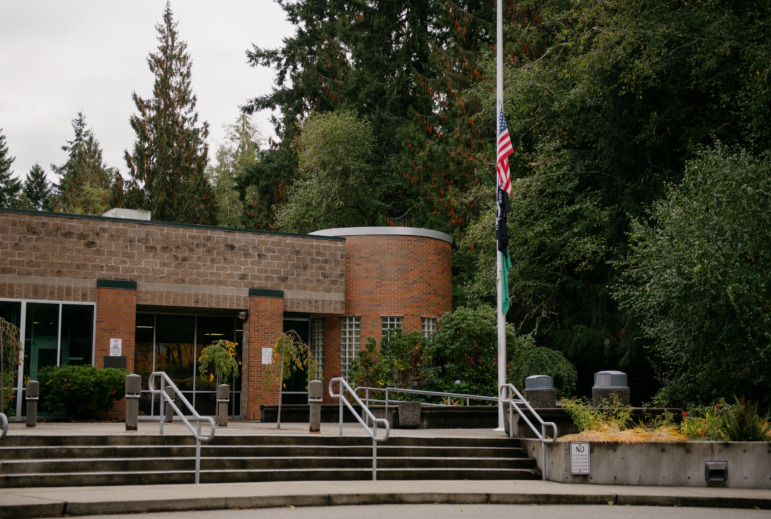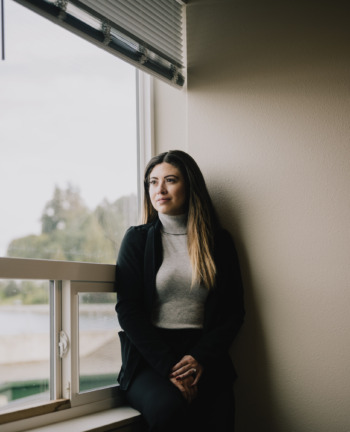PORT ORCHARD, Wash. — By 17, Pip was cycling in and out of Kitsap County’s juvenile court. He avoided going home to a “volatile” living situation where he said he could not express his true self. He struggled at work. Things felt dark.
“It was dangerous and really destructive for my mental health,” he said. Still, he stayed focused on certain goals, like graduating from high school.
In December 2022, a court-appointed therapist referred Pip, who asked to be identified by his nickname, to a newly expanded pilot program called H-SYNC, Housing Stability for Youth in Courts. When they told him the program could place him in stable housing, he said he initially thought it was a joke.
Listen and follow: Spotify | Apple Podcasts | Google Podcasts | Pocket Casts | RadioPublic
But then, H-SYNC navigator Megan Fultz got him into temporary housing, followed by an apartment of his own. The change gave Pip hope.
“I felt like I could keep going in life,” Pip told Crosscut and Youth Today. While living on his own, he graduated from high school. Since then, he has set his sights on college.
Nearly a quarter of young people who exit the Washington state justice system are homeless a year later. Young people leaving foster care or inpatient behavioral health become homeless at high rates as well. Five years ago, Washington enacted a law aimed at preventing this phenomenon.
As part of that effort, researchers and court staff worked together to design and study H-SYNC, with the goal of identifying at-risk youth, then getting them the help they need. In June, 2022, lawmakers allocated $625,000 to expand an H-SYNC pilot in four counties to a publicly funded, six-county program. The Legislature approved another $1.4 million this past spring to cover the next two fiscal years.
Washington was the first state to require that programs for court-involved youth be evidence-based, an approach that other states have followed. H-SYNC is one such program, and so far, officials say it has helped nearly 300 youth or their families. Because it’s designed to be adaptable, it could serve as a model elsewhere, while research findings could inform court-focused interventions in Washington and beyond.
On Pip’s 18th birthday, Fultz signed him up for Medicaid. Pip said he could finally begin talking to doctors and receiving gender-affirming care, including testosterone.
“That was the best birthday present I had ever received,” he said.
Connected through court
From mid-2020 to mid-2021, 830 young people ages 12 through 24 left juvenile rehabilitation or state prisons in Washington. A year later, a state report showed, 23% of them were homeless — likely an undercount, according to Alice Huber, the director of Research and Data Analysis at Washington’s Department of Social and Health Services. For comparison, 6% to 10% of similar youth who were not involved in the court system ended up homeless, a different report found.

Grant Hindsley/For Crosscut
Kitsap County Juvenile and Family Court Services seen on Oct 3, 2023. H-SYNC navigator Megan Fultz works in the building, but not for the court, attending hearings and building relationships with clients to help them maintain stable housing now and in the future after going through the judicial system at a young age.
The H-SYNC program serves youth ages 12 to 17½ who are involved in Washington’s juvenile courts. That can mean they’ve gotten in trouble with the law, or they might be involved in custody cases. If a young person shares a history of running away or other family conflicts, the court flags them and refers them to H-SYNC.
After receiving a referral, Fultz, who began as H-SYNC’s navigator in Kitsap County, a region with a growing population that covers a peninsula and two islands west of Seattle, in September 2022, will call a youth or their families to gauge their level of need.
“The youth are very reluctant at first,” Fultz said. “They don’t want to talk to me because they’re afraid I might talk to their probation officer.”
She said she emphasizes that she works at — not for — the court, and that as a clinician, anything they tell her is confidential, even from probation officers. Gradually, she establishes a rapport, then gets to work figuring out how to help her young clients and their families. She routinely manages a caseload of 20 to 25 clients.
Kitsap County, Fultz has discovered, has a dearth of housing. At times, she finds shelter beds for her clients outside the county. Often, she focuses on keeping a young person with their family — as long as the home is safe — rather than trying to find them housing elsewhere.
That, in turn, means finding the resources to help families become more stable. Some need help finding housing, others with making rent or utility payments, getting transportation to work or school or landing a job. Fultz also works directly with some families on communication and conflict resolution skills.
[Related: Washington’s new youth homelessness ‘Lifeline’ service lags]
If no program exists to meet a family’s need, Fultz has access to some discretionary funding through H-SYNC — just under $51,000 in the current fiscal year — she sometimes can draw on instead.
Fultz, who started her career at an inpatient facility for children and adolescents, called herself an “overwhelmingly positive and idealistic person” who is not easily discouraged. These qualities have been essential in tracking down resources for families.
“If they were difficult for me to find, as somebody who’s done this before,” she said, “how difficult are these resources for these youth and these families to find?”

Grant Hindsley/For Crosscut
Sheala Anderson, director of H-SYNC in Washington, photographed at Kitsap Mental Health Services in Port Orchard.
The state’s Office of Homeless Youth contracted with the YMCA of Greater Seattle to oversee the program, which now operates in six of Washington’s 39 counties. Sheala Anderson, H-SYNC’s statewide director, explained that the job of an H-SYNC navigator is to tailor a list of local resources for a youth or a family, depending on their needs, then actually connect them to the resources they want to use, following up for months afterward.
“The way that the navigator adapts in each county is different,” Anderson added, but the “mission” is the same.
From July 2022 through June 2023, H-SYNC served 145 youth and families, according to Anderson, and from July through September of this year, another 32. In the counties that gathered demographic data, most clients — 68% — chose not to disclose their race or ethnicity. About 48% identified as cisgender women, 37% as cisgender men and just under 15% chose not to disclose their gender, according to results Anderson shared.
“It’s been invaluable,” said Amie Greist, a court therapist in Kitsap County who has referred clients to H-SYNC. “We’ve been able to help youth” that previously the court had been unable to help, Greist explained, adding, “When Megan [Fultz] came on board, it changed the lives of several youth that I think wouldn’t have had those resources otherwise.”
Measuring success
About five years ago, two Seattle-based philanthropies, the Block-Leavitt Foundation and the Raikes Foundation, approached Sarah Walker, director of the University of Washington’s CoLab for Community and Behavioral Health Policy, with a very specific question: What could be done to help prevent homelessness among youth who were involved in the legal system?
(The Raikes Foundation provided funding for this and previous reporting projects via Crosscut’s partnership with Youth Today. Crosscut and Youth Today maintain complete editorial control over this and any related stories.)
Walker’s research team, along with workgroups in Snohomish and Kitsap counties, began digging into juvenile court data and interviewing local service providers.
They found that, of the roughly 6,800 youth who’d been referred to courts in 2017, 40% to 60% had a history of running away, being kicked out or living without adult supervision. So, to avoid creating new work for overburdened juvenile courts, the team decided to use a standard court survey, which included questions about family dynamics and running away, to screen young people for their risk of homelessness.
As they worked to design H-SYNC, they wanted it to be both replicable and adaptable across different counties, Walker said. In 2019, a pilot version launched in four counties, funded by a mix of philanthropic and public dollars. As the program has expanded, Walker and the research team have continued to analyze its effectiveness.
The fact that researchers are studying H-SYNC so closely, or at all, is unusual among efforts to address youth homelessness.
[Related: Washington’s $5M youth homelessness effort is ramping up. Is it working?]
Nationwide, there are “few rigorous evaluations” of such various efforts, a systematic review from 2020 found. It called for more careful assessments of interventions “to inform more conclusive policy and practice decisions.”
The team assessing H-SYNC is now examining what works, as well as what could be better.
By 2021, the program had made 107 referrals across the four counties, and Walker and her team were pleased to see that youth of color, who are disproportionately represented in the justice system, were more likely to use its services. At the same time, they also found that H-SYNC wasn’t reaching all of the youth or families who could have used it because the court survey still missed some warning signs.
“We know that we’re not hitting that at 100 percent,” Walker said. In the team’s latest round of analysis, she added, they found that youth substance use was another potential predictor of homelessness — one they hadn’t previously considered.
It’s a useful data point, Walker said, “something that we will take back to the sites and say, ‘Here’s another consideration for referring youth into the program.’” She and her team are currently preparing two papers on H-SYNC.
They’ve also found that not everyone who receives a referral to H-SYNC ultimately uses its services. Understanding why presents a challenge, because the research team tended to interview families that liked the program, not those who’d chosen to skip it, Walker pointed out.
Eventually, the state is also supposed to track the long-term outcomes of H-SYNC, but a spokesperson for the Department of Commerce told Crosscut and Youth Today they are still determining what that evaluation will include. A report is due to the Legislature in October 2025.
Beyond material needs
Working with Fultz changed Pip’s life.

Grant Hindsley/For Crosscut
Megan Fultz, Housing Stability for Youth in Courts navigator in Kitsap County, participates in a monthly meeting with other navigators across Washington at Kitsap Mental Health Services in Port Orchard.
Fultz made sure the teen had tangible necessities: A mattress and bed for his apartment, so he wasn’t sleeping on the floor. Clothing. A uniform and shoes for work. EBT. New glasses. An electric bike to help him get to work.
(Pip missed work to speak with Crosscut and Youth Today, and afterward, Fultz gave him a gift card. H-SYNC officials later confirmed Pip had not been told in advance he would be compensated. Crosscut and Youth Today do not pay for interviews.)
Then, there are the intangible ways Fultz has helped him.
“I’m a very different person today than I used to be when I was first involved with the court system,” Pip said.
Today, he said, he’s confident, able to speak his mind and express his opinions without looking to someone else for approval. He said he has earned a promotion at work, too, and his gender-affirming care has “done wonders” for his mental health. Pip said he hopes to enroll soon at Olympic College in Bremerton.
He added, “I want to do what Megan does when I’m a bit older.”
[Related: Washington homelessness group exposed sensitive data on kids, young adults]
During an interview this fall, as Fultz sat beside him, Pip recalled a time when Fultz took him to Target to buy paper towels and other household necessities. Pip hadn’t eaten, so she bought him lunch. They sat in a park by the water to eat.
Pip was upset with one of his relatives, he recalled, but talking with Fultz helped him calm down. He did not need to sacrifice himself for the sake of pleasing his family, she told him.
“That changed my life,” he said. “I stopped beating myself up about my family.”
Fultz murmured, “I didn’t know that,” her voice breaking slightly. “Don’t cry!” Pip said, trying to reassure her.
Pip aged out of H-SYNC in October, which means his relationship with Fultz is formally over.
“He’s got all the resources he needs,” Fultz said, sounding both sad and proud. “I think he’s going to be great.”
***
Elizabeth Whitman is a freelance journalist in the Seattle area. She can be reached at elizabeth.whitman@proton.me.
Sam Leeds is an independent producer and sound artist living in Seattle.
This article is part of an ongoing series on homelessness in Washington state, done in collaboration with Crosscut. It is made possible in part by support from the Raikes Foundation. Youth Today and Crosscut maintain editorial control.






























